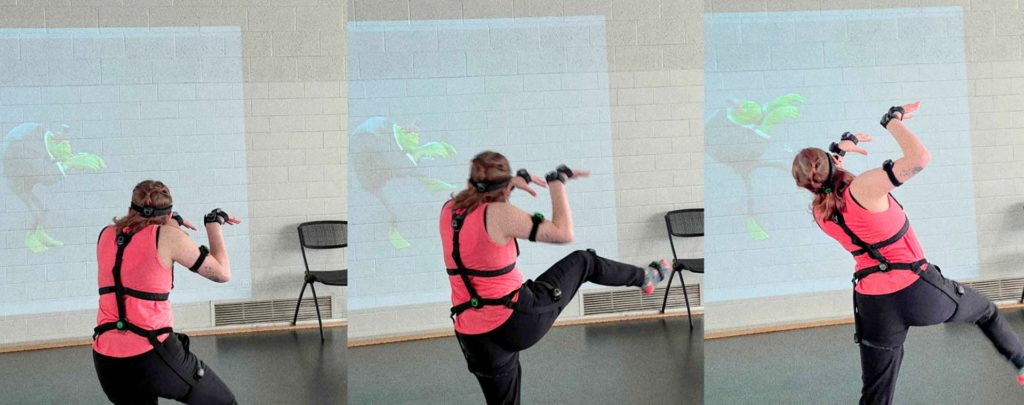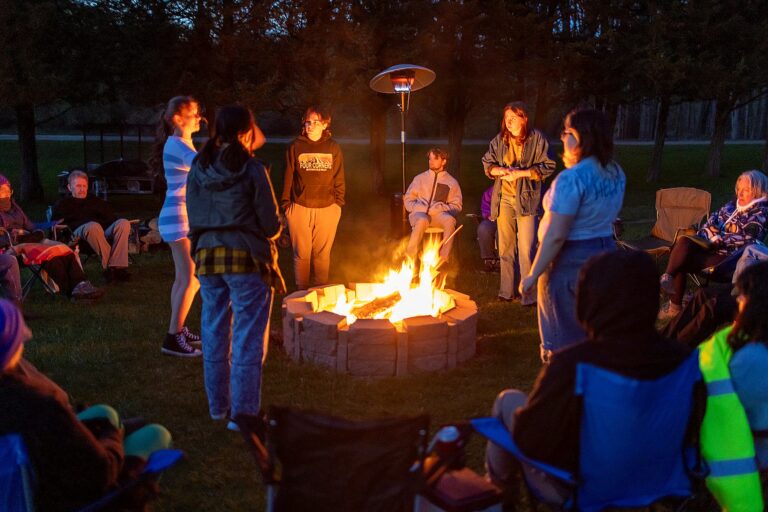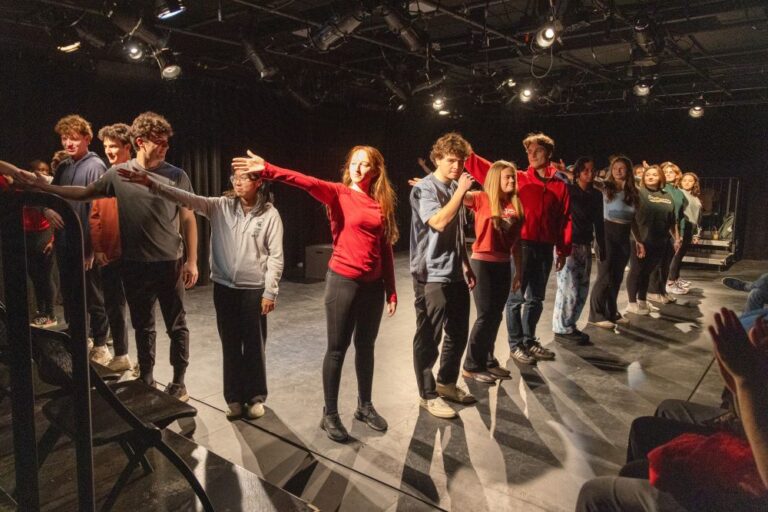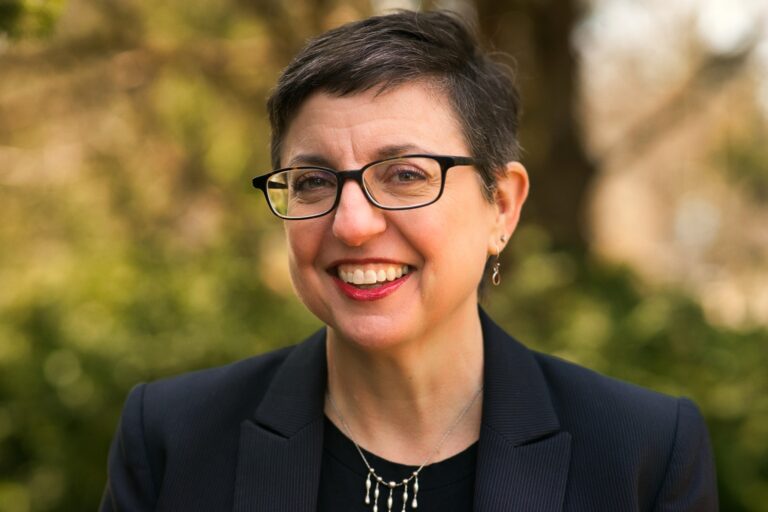Innovation by Michigan State University faculty isn’t limited to their research. Faculty continuously look for ways to engage students in their own instruction and prepare them for opportunities to stand out following graduation.
With support from the Center for Teaching and Learning Innovation Catalyst Innovation Program, faculty can receive funding to purchase the latest technology and software to weave into their classes and curriculum. Students learn how to use technology as well as explore creative ways to incorporate it into their academic journeys.
Take a look at some classes breaking the mold.
Experimenting with Motion and Emotion
Movement is a familiar yet complex word. Everyone moves but not in the same way. Movement also has the power to convey meaning, even culture.
“We began to explore ways for students to experience movement and interact with others who are moving in a virtual space,” said Brad Willcuts, Associate Professor of Musical Theatre, Choreography, and Dance in the Department of Theatre. “There is a unifying disconnect in movement in that when you pay attention and note the movement, it isn’t about the clothes or the setting. It has an incredible opportunity for expression.”

Willcuts enlisted the help of Educational Media Design Specialist Daniel Trego, also in the College of Arts & Letters, as well as Grace Krajewski, a third-year student in Lyman Briggs College. Krajewski, who is majoring in Human Biology with a minor in Dance, helps Trego and Willcuts test the different capabilities of motion-capture suits and explore the possible uses of avatars — a computer representation of users in the virtual space.
“My goal is to go to medical school but, as a lifelong dancer, I think it is important to mesh STEM and the arts,” Krajewski said. “I hope as more students experiment with these processes, they realize how much they can benefit from both.”
Building on his explorations, Willcuts and Ryan Welsh, Assistant Professor of Media Acting in the College of Arts & Letters, task students in their New Media Laboratory class with using augmented reality to produce a short performance in which they play both characters. Students record their performance as one character, then the other character while wearing a motion-capture suit. The second character becomes a digital recording the students add to the recording of the first character using augmented reality.
“This isn’t a traditional lecture-style class. We think of it more as a laboratory where artists can experiment with different methods and ideas.”
Brad Willcuts, Associate Professor of Musical Theatre, Choreography, and Dance
“There is a lot to consider,” Willcuts said. “What story do you want to tell? How do you move like a completely different character? How do you interact with someone who isn’t there but still have it be seamless for the final production?
“This isn’t a traditional lecture-style class. We think of it more as a laboratory where artists can experiment with different methods and ideas.”
Throughout the process students learn cinematography, video editing, laying an audio track, and digital creation on a small budget. They also explore movement and how it can convey a story.
Making Feedback More Objective
When it comes to interior design, it is easy to be a critic. But design is more than a matter of personal taste. To help address misconceptions, MSU faculty are committed to fostering a positive learning environment by using cutting-edge technology.
“There can be a lot of tension when providing feedback, especially if students perceive instructors are being overly harsh,” said Linda Nubani, Director of the Interior Design Program in the College of Agriculture and Natural Resources. “Taking that element out helps the students focus on connecting the principles they’ve learned to their work.”

Nubani and her colleagues are employing eye-tracking software in the evaluation of the computerized 3D models students produce of their projects. The software creates heat maps indicating where the viewer’s eyes stopped first and for how long — basically what captures their attention.
“The results unveil the subconscious thoughts and reactions of individuals to the design. We gain insights into how diverse perspectives perceive the work without a single word being spoken,” Nubani said.
Aligned with the principles of design such as scale, proportion, color, harmony, balance, and complexity, students utilize the eye-tracking software to subjectively identify areas where these principles may be underrepresented in their designs.
Learning at Your Own Pace
Students learn in different ways and at different paces. It can be challenging for a single instructor in a laboratory with multiple stations and assignments to meet the needs of each student.
“Students tend to use their phones a lot nowadays, so we thought, ‘Let’s meet them where they are and provide content that is useful,’” said Sunil Kishore Chakrapani, Assistant Professor of Electrical and Computer Engineering in the College of Engineering.

QR codes can be found around the Computer Aided Manufacturing lab in, on, and next to multiple pieces of equipment. The different codes connect students to a variety of online information, including an equipment manual, instructional videos on how to use equipment, checklists, and quizzes.
“The QR-coded checklists allow students to complete the lab experiments at their own pace. If a student is picking up on the information, they can go forward without waiting for an instructor in the room to sign off on items in the checklist,” Chakrapani said. “At the same time, instructors can dedicate more time on students who need the support.”
“The QR-coded checklists allow students to complete the lab experiments at their own pace. If a student is picking up on the information, they can go forward without waiting for an instructor in the room to sign off on items in the checklist.”
Sunil Kishore Chakrapani, Assistant Professor of Electrical and Computer Engineering
The lab experiments include steps completed online as well as instructions to interact with the equipment. During some experiments, students need to move from station to station and must find the correct QR codes in the room to continue. The aim is to improve student engagement and increase the accessibility of the content as well as one-on-one time with instructors.
Chakrapani is working with Jenifer Saldanha, a colleague in the College of Natural Science, to implement the QR codes in a biological sciences course as well.
Exploring a Different Reality
The height of the COVID-19 pandemic introduced faculty and students to the benefits of virtual work and study. It also showed the challenges with staying connected and engaged from the other side of a screen.
“I hope to introduce students to the future of virtual education in the metaverse and how we can be in different places but still participate in experiential learning,” said Rabindra “Robby” Ratan, Associate Professor of Media and Information in the College of Communication Arts and Sciences. He is a two-time recipient of MSU’s AT&T Excellence in Teaching with Technology Award.

Twice a week, students in the Avatar Psychology and Understanding Virtual Reality Experiences join the classes using a VR headset. Students then have discussions, break out into small groups, create and move 3D objects, and answer questions by teleporting to the front of the room, even changing their surroundings throughout class.
“We still experience a social presence like we were together in a room,” Ratan said. “At the same time, students are gaining a media literacy that will benefit them in their future employment.”
“I hope to introduce students to the future of virtual education in the metaverse and how we can be in different places but still participate in experiential learning.”
Rabindra “Robby” Ratan, Associate Professor of Media and Information
Students also explore the psychological impacts of VR technology and the possibilities it presents in communication, business, and society. Throughout the semester, students are challenged to create different avatars including realistic and unrealistic versions of themselves. Then the class discusses how they perceive one another in different appearances.
“I’ve seen a really cool phenomenon in how behavior changes in the virtual space versus the times we meet in person. Some students get really comfortable speaking up in VR, yet are not talkative in person,” said Alex Lover, a graduate student in the College of Communication Arts and Sciences who serves as a Teaching Assistant for the classes. “I think students also learn to communicate with each other. With the discussion-based style, they learn to articulate their thoughts and make a compelling argument. Being able to make yourself understood and defend your position is a strong skill to have for their future.”
Written by Deon Foster and Melody Kindraka and originally published by MSU Today.


